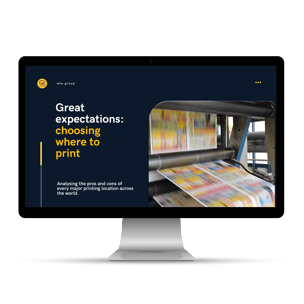It’s a truth universally known that there is nothing quite like a printed book. Despite the rise of e-books, podcasts, audiobooks and all other new-fangled digital ways of putting words out in the world, printed books continue to defy the odds and prove their value in the market. Thanks to the delight of being more “instagrammable”, physical books are going through a renaissance of popularity. However, for those of us invested in the printed word beyond simply as a Zoom background, this new-found love of books sparks questions and forces businesses to re-evaluate their supply chain set up.
“I don’t think print is going away. There’s always going to be print, there’s always going to be e-books, there’s always going to be audiobooks.”
Cevin Bryerman, CEO & Publisher, Publishers Weekly.
With demand for printed books on the up and up, businesses are under more pressure than before to keep up and ensure their production processes are the most efficient as possible. A vital link in this chain is the location where the printing takes place, as it can have a great impact on the efficiency of a supply chain (and consequently profits) of a business. The wta group research report “Great Expectations: choosing where to print” explores this matter in further detail which you can download below.
There are several locations around the world which are prime options to consider for your printing needs, each offering its own set of opportunities and drawbacks for businesses, and it’s important to evaluate the big picture before making your choice. While China may seem like the obvious answer, our research report investigates many of the key destinations globally to best understand just how viable each option is for the printing community. Weighing up labour costs, availability of printing suppliers, sustainability strategies and more, this whitepaper aims to offer an insightful guide to helping you choose the right place for you.
“For a publisher or print broker, having several choices within a specific geographic area is a must as it makes sense in terms of efficiency and logistics.”
Teri Tan, International Correspondent, Publishers Weekly.
As Tennessee Williams put it best, time is the longest distance between two places, and that's as true as ever when it is considered in the context of a supply chain. Distance does not always need to be the restricting factor when it comes to choosing where to print, as the crucial element is time. Transit time plays a vital role, and you may find, for example, that nearshoaring is the most effective solution for your individual needs. After all, you must weigh up what offers your business the most value, cheaper production value or arriving at the destination in the least amount of time? The answers to these questions will help determine just how far you look for a suitable location to print.
If the rising popularity of printed books in recent years have caused you to start rethinking where you get your printing done to maximise your efficiency and profit margins, then this whitepaper is a great tool for you. The WTA team are also always available to offer guidance and bespoke solutions suitable to you and your business, to help overcome any logistical challenges you may be facing, so don’t hesitate to get in touch if you have any questions.
Liam Launders, Head of Sales, WTA Group









